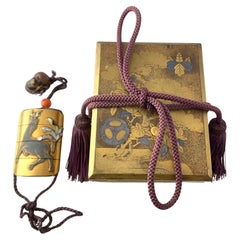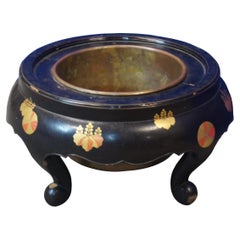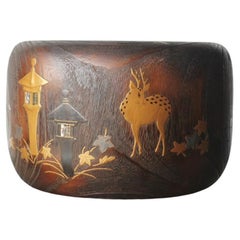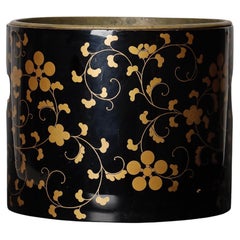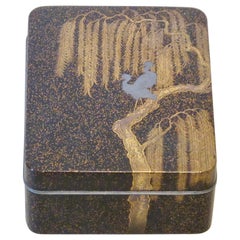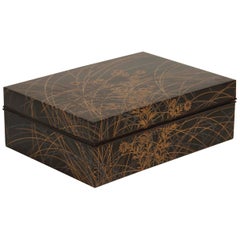Japanese Makie Lacquer
20th Century Japanese Lacquer
Wood, Lacquer
Antique 1890s Japanese Meiji Lacquer
Wood, Lacquer
Antique 19th Century Japanese Edo Lacquer
Brass
Antique 19th Century Japanese Lacquer
Wood
Antique 19th Century Japanese Edo Lacquer
Bronze
Recent Sales
Antique Late 19th Century Japanese Meiji Lacquer
Wood
Mid-20th Century Japanese Showa Lacquer
Lacquer
Antique 19th Century Japanese Edo Lacquer
Lacquer
Antique 19th Century Japanese Edo Lacquer
Stone, Metal
Antique 18th Century Japanese Edo Lacquer
Wood, Lacquer
Mid-20th Century Japanese Showa Lacquer
Lacquer
Antique Late 19th Century Japanese Meiji Paintings and Screens
Lacquer
Antique Late 19th Century Japanese Meiji Paintings and Screens
Lacquer
Antique Late 19th Century Japanese Meiji Paintings and Screens
Lacquer
People Also Browsed
Antique Late 19th Century Japanese Meiji Lacquer
Metal
Early 20th Century Chinese Art Deco Chinese and East Asian Rugs
Wool
Antique Late 19th Century Japanese Lacquer
Lacquer
Antique 19th Century Japanese Japonisme Lacquer
Wood, Lacquer
Antique Mid-19th Century Japanese Edo Lacquer
Metal, Bronze, Copper
Antique 17th Century Japanese Edo Lacquer
Copper, Gold
Japanese Makie Lacquer For Sale on 1stDibs
How Much is a Japanese Makie Lacquer?
Finding the Right Asian Art And Furniture for You
From Japanese handmade earthenware pottery, originating circa 14,500 B.C. and adorned with elaborate corded patterns known as jōmon, to natural elm case pieces and storage cabinets built in Qing dynasty–era China to mid-century Thai rice-paper charcoal rubbings, antique and vintage Asian art and furniture make for wonderful additions to all kinds of contemporary interiors.
Eastern elements elevate any home’s decor. Introduce zen sensibility to your living room, dining room and bedroom with the neutral color palettes and the natural materials such as rattan, bamboo and elm that we typically associate with traditional Asian furniture. Decorative handwoven embroideries and textiles originating from India and elsewhere on the continent, which can be draped over a bed or sofa or used as a wall hanging, can be as practical as they are functional, just as you wouldn’t seek out Japanese room-divider screens — often decorated with paintings but constructed to be lightweight and mobile — merely for privacy.
With everything from blanket chests to lighting fixtures to sculptures and carvings, it’s easy to tastefully bring serenity to your living space by looking to the treasures for which the East has long been known.
For British-born furniture designer Andrianna Shamaris, the Japanese concept of beauty in imperfection isn’t limited to her Wabi Sabi collection. She embraces it in her New York City apartment as well. In the living area, for instance, she retained the fireplace’s original black marble while swathing its frame and the rest of the room in bright white.
“We left the fireplace very clean and wabi-sabi, so that it blended into the wall,” says Shamaris, who further appointed the space with a hand-carved antique daybed whose plush pillows are upholstered in antique textiles from the Indonesian island of Sumba.
In the growing antique and vintage Asian art and furniture collection on 1stDibs, find ceramics from China, antiquities from Cambodia and a vast range of tables, seating, dining chairs and other items from Japan, India and other countries.
- 1stDibs ExpertApril 5, 2022Japanese lacquer is made of resin produced from the sap of the Urushi tree. Artisans craft bowls, vases, boxes and other items out of the material. Find a collection of Japanese lacquer furniture and decorative objects and art on 1stDibs.
- 1stDibs ExpertApril 5, 2022You can restore Japanese lacquer that has been damaged by exposure to light by gently buffing it with carnauba wax. Use a soft cloth to gently rub the wax into the piece, removing any excess and avoiding undamaged lacquer. Take a look on 1stDibs for a variety of pieces featuring Japanese lacquer.
- 1stDibs ExpertApril 5, 2022To clean a Japanese lacquer box, start by moistening a soft lint-free cloth with warm water. Ring it out and then gently rub every surface. Do not use soap as it may damage the lacquer. Dry the box promptly with a second soft, dry lint-free cloth. On 1stDibs, find a variety of Japanese lacquer boxes.
- 1stDibs ExpertApril 5, 2022Japanese lacquerware items are finished with a sap that comes from the lacquer tree. This finish is prone to degradation, especially if exposed to sun and water, and age will take its toll as well. To clean lacquerware items, wet a lint-free cloth and wring as much water out as you can, then wipe the item. Finish by drying it with a soft lint-free cloth. Shop a range of antique and vintage Japanese lacquerware on 1stDibs.
- 1stDibs ExpertApril 5, 2022To fix Japanese black lacquer, take it to a furniture repair shop that has previously worked with the material. Lacquer is very delicate. Attempting to fix a piece on your own could cause further damage. On 1stDibs, find a selection of Japanese black lacquer.
- 1stDibs ExpertApril 5, 2022Yes, there is a type of varnish called Japanese lacquer. It is made from the sap of an urushi tree, which grows in Japan, China and Southeast Asia. On 1stDibs, you can find vintage and modern Japanese lacquered pieces from some of the top sellers around the world.
Read More
Chicago’s Pagoda Red Has a Spirited Mix of Asian Antiques and Bold New Art
For 25 years, gallerist Betsy Nathan has leveraged her keen eye and key connections to bring a unique selection of rare finds to the market.
In L.A., Gallerist JF Chen Has Long Championed Eclectic Blue-Chip Design
Now working alongside his daughter Bianca, dealer Joel Chen has presented a most covetable array of antiques, art and contemporary creations for more than 40 years.
12 Calming Spaces Inspired by Japanese Design
From cherry-blossom-adorned walls paired with glamorous lighting to wood-paneled ceilings above checkerboard-patterned chairs, these 12 spaces seamlessly blend Eastern and Western aesthetics.
Rodrigo Rivero Lake’s Mexico City Showroom Is a Museum-Worthy Trove of Spanish Colonial and Asian Antiques
The dealer and curator has spent the past 50 years amassing a collection of exceptional art, furniture and architectural elements that trace the cultural influence of the Spanish empire from Europe to the Americas and beyond.
16 Refined Asian-Inspired Interiors
These spaces exemplify how Eastern elements elevate a home's decor.

